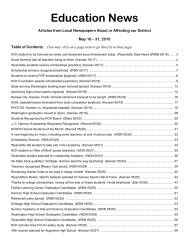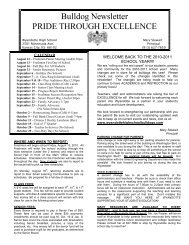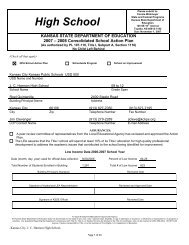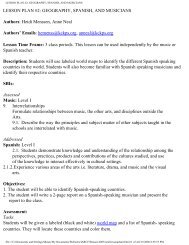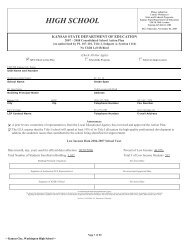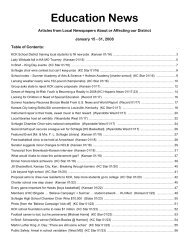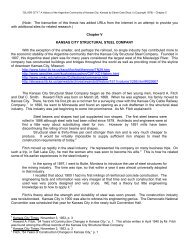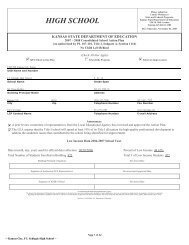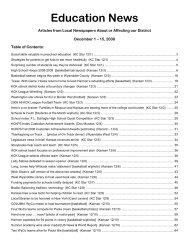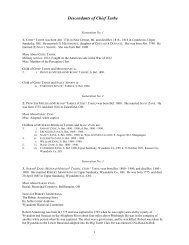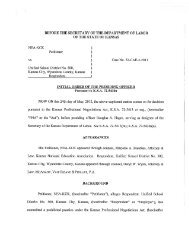<strong>Kansas</strong> Liberty: 06 <strong>March</strong> 2009<strong>Kansas</strong> taxpayers may have spent almost $52 million for the 2008-2009 school year onstudents who were actually ineligible for free lunches.Education committee attempts tountangle 'at-risk' funding messThe House Education Committee heard testimony yesterday on legislation that would alter how at-riskfunding is allocated to schools by incorporating U.S Census Bureau data into the distribution formula forfunding.Currently the at-risk funding is based on the number of students who qualify for free lunches under federalguidelines. The result can be a misdirection of resources resulting in massive spending errors. In 2008-2009, these errors may cost <strong>Kansas</strong> taxpayers more than $50 million.That figure comes from data included in a November 2006 Performance Audit Report in the LegislativeDivision of Post Audit that showed approximately 17 percent of <strong>Kansas</strong> students determined to qualify forthe free lunches were actually ineligible for the benefits.The report calculated the state paid out $19 million for at-risk benefits for about 23,000 ineligible studentsin the 2005-2006 school year. In 2008-2009, that figure may have risen to $52 million.Rep. Clay Aurand, R-Courtland, and chair of the Education Committee, said the legislation, HB 2357, seeksto ensure that school districts which deserve the funding are the ones to which the additional at-risk fundsare actually allocated.“I want to stop sending more money to the wrong schools for the wrong reasons,” Aurand toldthe committee. “And we should all agree that the money should go to the schools where thekids in poverty are.”Free-lunch students must have household incomes of less than 130 percent of the poverty level and themajority of the students determined to be ineligible through the report had household incomes greaterthan that allowed amount.The research used a random sample of 500 <strong>Kansas</strong> students who had been classified asqualifying for free lunches. From those 500 students, 85 were found to be ineligible for thefree-lunch program, with 62 households of those students having an income of 20 percent orhigher than the limit, and 12 of those 62 earned double the income of the limit.One of the students who was receiving free-lunch benefits had a household annual income of more than$168,000.According to the executive summary of the report, “many households are able to under-report their incomeand still receive free lunches because federal law requires school district officials to accept theirapplications at face value.”Cheryl Semmel, executive director of the United School Administrators of <strong>Kansas</strong>, said in her testimonythat it was important to note the Legislative Post Audit had access to information that <strong>Kansas</strong> schooldistricts can not legally obtain.“There has been continued speculation that school districts are over-identifying students,”
Semmel said in her testimony. “I would like to reiterate that this is not true. While theLegislative Post Audit report on at-risk funding…found that 17 percent of students surveyedshould not be eligible for free lunch because their actual incomes were too high, the reportfound no evidence that school districts were deliberately over-identifying students.”<strong>Schools</strong> in <strong>Kansas</strong> receive extra funding for at-risk programs through a formula that uses the amount ofstudents who are eligible for free lunches. For the 2008-2009 school year the base state aid for pupils wasset at $4,400 per student. To determine additional funding for at-risk programs, that $4,400 is multipliedby .456, to reach a total of additional $2,006 in funding for each student who qualified for free lunches.Brad Neuenswander, director of the Division of Financial Services at the <strong>Kansas</strong> State Department ofEducation said the unofficial number of students who applied for free lunches for the 2008-2009 schoolyear is 152,202.Based on these numbers <strong>Kansas</strong> schools received more than $305 million for funding at-risk programs forthe 2008-2009 school year. If the 2006 post audit report’s estimate of how many students are receivingfree lunches erroneously is applied, then the state would have paid out almost $52 million for the 2008-2009 school year to students who were actually ineligible for free lunches.Aurand, as well as other legislators and members of the education community also said it was important toremember that some students who are eligible for free lunches do not always apply for the service becauseof cultural reasons, or embarrassment about the family’s income. So while some may be receiving freelunches who are not eligible to do so, other students who should be receiving free lunches are not applyingfor them.“More people than not are under-reporting because they don’t want the stigma,” said TomKrebs, governmental relations specialist for the <strong>Kansas</strong> Association of School Boards, at thehearing.The Post Audit Report said that based on a survey of school district officials, about 6,900 students thatcould be receiving benefits were not applying for them - far less than the report’s estimated 23,000 inineligible students who were receiving the benefits. However opponents of the legislation argued the 6,900was a gross underestimate of how many students were not applying for benefits.While free-lunch student numbers are used to determine how much additional funding schools will get,these students are not necessarily the ones who benefit from the money. The additional funds must gotowards funding programs that can benefit at-risk students, and students who qualify for free lunches donot always meet the at-risk requirements.“At-risk funding is designed to provide additional educational assistance for children who are at risk of notperforming well and the free lunch application is used because it is one indicator of being a low-incomechild and the data shows that low income children are at a greater risk of being a low performer,” JodiMackey, director of child nutrition and wellness at the <strong>Kansas</strong> State Department of Education, told <strong>Kansas</strong>Liberty.- Holly SmithResources• Read the post audit report: http://www.kslegislature.org/postaudit/audits_perform/06pa12.1a.pdf• Read the bill: http://www.kslegislature.org/bills/2010/2357.pdf• <strong>Kansas</strong> State Department of Education: http://www.ksde.org
- Page 1 and 2:
Education NewsArticles from Local N
- Page 3 and 4:
KCK League Defensive Player of the
- Page 5 and 6: The Harmon Hawks earned revenge Fri
- Page 7 and 8: Kansan - March 1, 2009Schlagle ends
- Page 9 and 10: Kansan - March 1, 2009"Tails" earns
- Page 11 and 12: Derek Lysinger, a fourteen-year old
- Page 13: own dedicated time and money.Now, t
- Page 17 and 18: The marquee witness at the hearing
- Page 19 and 20: School leaders say students in the
- Page 21 and 22: Posted by Mark ZaringI saw that too
- Page 23 and 24: “I started inside and worked my w
- Page 25 and 26: FIRST TEAM• G - Neil Watson, Sumn
- Page 27 and 28: Kansan - March 2, 2009Sumner, Piper
- Page 29 and 30: Back to web versionPosted on Sun, M
- Page 31 and 32: Wyandotte West - March 2, 2009High
- Page 33 and 34: Kansan - March 3, 2009KCK player ea
- Page 35 and 36: Kansan - March 4, 2009Wyandotte's N
- Page 37 and 38: Kansan, March 5, 2009RECAPS: Girls
- Page 39 and 40: Austin Neff got sick, along with 13
- Page 41: Repeat OffendersOf public schools,
- Page 52 and 53: Kansan, March 6, 2009Sumner routs P
- Page 54 and 55: Kansan, March 6, 2009Wyandotte shoc
- Page 58 and 59: at risk fundingWhile it is a reason
- Page 60 and 61: Wyandotte West - March 6, 2009Subst
- Page 62 and 63: leading scorer with 13 points in th
- Page 64 and 65: Back to web versionPosted on Fri, M
- Page 66 and 67: Banks, who hit four three-pointers
- Page 68 and 69: Kansan - March 8, 2009Holliday domi
- Page 70 and 71: The Thunder’s last lead of the ga
- Page 72 and 73: Kansan - March 8, 2009Sumner begins
- Page 75 and 76: SM South’s Haake takes third in K
- Page 77 and 78: St. Thomas Aquinas boys edge Wyando
- Page 79 and 80: After reading about convicted kille
- Page 81 and 82: Rose’s students said they have no
- Page 83 and 84: Kansan - March 9, 20092008-2009 All
- Page 85 and 86: 189 lbs215 lbs1st Team: Elijah Ming
- Page 87 and 88: In a criminal case, where the burde
- Page 89 and 90: Kansan - March 10, 2009Community Ca
- Page 91 and 92: Kansan - March 10, 2009KCK League N
- Page 93 and 94: KMBC-9 News - March 10, 2009OBAMA:
- Page 95 and 96: Back to web versionPosted on Tue, M
- Page 97 and 98: Back to web versionPosted on Tue, M
- Page 99 and 100: Kansan - March 11, 2009Board approv
- Page 101 and 102: Kansan - March 11, 2009Stimulus mon
- Page 103 and 104: Kansan - March 11, 2009Sumner, Wash
- Page 105 and 106: Back to web versionPosted on Tue, M
- Page 107 and 108:
Lansing boys, girls teams to play a
- Page 109 and 110:
Back to web versionPosted on Tue, M
- Page 111 and 112:
Star - March 11, 2009Obama favors m
- Page 113 and 114:
An evaluation of teachers needs to
- Page 115 and 116:
Back to web versionPosted on Tue, M
- Page 117 and 118:
Wyandotte West - March 11, 2009BUDG
- Page 119 and 120:
Kansan - March 12, 2009A further st
- Page 121 and 122:
"Our game plan was the slow them do
- Page 123 and 124:
Kansan - March 12, 2009KCK students
- Page 125 and 126:
Bulldogs to a huge upset victory ov
- Page 127 and 128:
Kansan - March 12, 2009KCK League D
- Page 129 and 130:
Just a freshman, Parker should be a
- Page 131 and 132:
Kansan - March 12, 2009Piper to inc
- Page 133 and 134:
Back to web versionPosted on Wed, M
- Page 135 and 136:
Wyandotte West - March 12, 2009Stat
- Page 137 and 138:
Wyandotte West - March 12, 2009High
- Page 139 and 140:
Kansan - March 13, 2009KCK League P
- Page 141 and 142:
Kansan - March 13, 2009Wyandotte Hi



